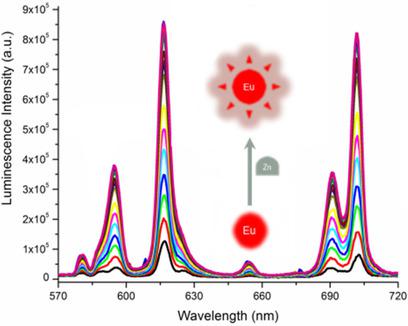当前位置:
X-MOL 学术
›
ChemPlusChem
›
论文详情
Our official English website, www.x-mol.net, welcomes your
feedback! (Note: you will need to create a separate account there.)
Europium(III) Macrocyclic Chelates Appended with Tyrosine-based Chromophores and Di-(2-picolyl)amine-based Receptors: Turn-On Luminescent Chemosensors Selective to Zinc(II) Ions.
ChemPlusChem ( IF 3.0 ) Pub Date : 2020-01-22 , DOI: 10.1002/cplu.201900731 Gaoji Wang 1 , Carlos Platas-Iglesias 2 , Goran Angelovski 1
ChemPlusChem ( IF 3.0 ) Pub Date : 2020-01-22 , DOI: 10.1002/cplu.201900731 Gaoji Wang 1 , Carlos Platas-Iglesias 2 , Goran Angelovski 1
Affiliation

|
Zinc ions play an important role in many biological processes in the human body. To selectively detect Zn2+ , two EuDO3A-based complexes (DO3A=1,4,7,10-tetraazacyclododecane-1,4,7-tricarboxylic acid) appended with tyrosine as a chromophore and di-(2-picolyl)amine (DPA) as the Zn2+ recognition moiety were developed as suitable luminescent sensors. Their luminescence intensity is affected by the photoinduced electron transfer mechanism. Upon addition of Zn2+ , both probes display an up to sevenfold enhancement in Eu3+ emission. Competition experiments demonstrated their specificity toward Zn2+ over other metal ions, while also revealing the nonspecificity of the derivatives lacking the DPA-moiety, thus confirming the essential role of the DPA for the recognition of Zn2+ . The induced emission changes of Eu3+ allow for precise quantitative analysis of Zn2+ , establishing these lanthanide-based complexes as viable chemosensors for biological applications.
中文翻译:

Ty(III)大环螯合物,加上基于酪氨酸的发色团和基于二-(2-吡啶甲基)胺的受体:对锌(II)离子具有选择性的开启式发光化学传感器。
锌离子在人体的许多生物过程中起着重要作用。为了选择性地检测Zn2 +,两个基于EuDO3A的配合物(DO3A = 1,4,7,10-四氮杂环十二烷-1,4,7-三羧酸)加上酪氨酸作为生色团和二-(2-吡啶甲基)胺(DPA) Zn2 +识别基团的“ SnO”被开发为合适的发光传感器。它们的发光强度受光诱导电子转移机制的影响。添加Zn2 +后,两个探针的Eu3 +发射强度最多提高7倍。竞争实验证明了它们对Zn2 +相对于其他金属离子的特异性,同时还揭示了缺乏DPA部分的衍生物的非特异性,从而证实了DPA在识别Zn2 +方面的重要作用。
更新日期:2020-01-22
中文翻译:

Ty(III)大环螯合物,加上基于酪氨酸的发色团和基于二-(2-吡啶甲基)胺的受体:对锌(II)离子具有选择性的开启式发光化学传感器。
锌离子在人体的许多生物过程中起着重要作用。为了选择性地检测Zn2 +,两个基于EuDO3A的配合物(DO3A = 1,4,7,10-四氮杂环十二烷-1,4,7-三羧酸)加上酪氨酸作为生色团和二-(2-吡啶甲基)胺(DPA) Zn2 +识别基团的“ SnO”被开发为合适的发光传感器。它们的发光强度受光诱导电子转移机制的影响。添加Zn2 +后,两个探针的Eu3 +发射强度最多提高7倍。竞争实验证明了它们对Zn2 +相对于其他金属离子的特异性,同时还揭示了缺乏DPA部分的衍生物的非特异性,从而证实了DPA在识别Zn2 +方面的重要作用。











































 京公网安备 11010802027423号
京公网安备 11010802027423号